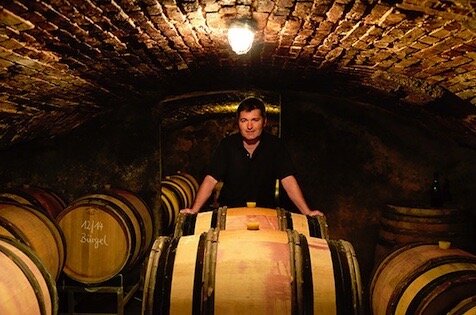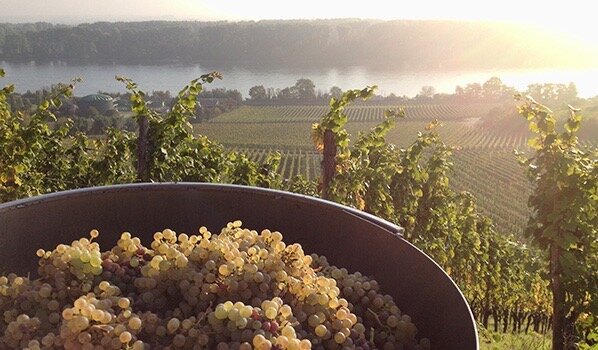WEINGUT KELLER
Flörsheim-Dalsheim
The Keller family has been making wine in Flörsheim since 1789. Klaus-Peter is the 9th generation of Keller to grow vines and make wine in the region. He often pays tribute to the preceding generations of the family, and above all his parents, for laying the foundations of his own success.
Prior to joining the family winery, Klaus-Peter wanted to learn about viticulture in other regions. In the early 1990s, he decided to spend time in Burgundy, a region he was particularly fascinated with, and did a few internships, one of which was at Domaine Rousseau.
Klaus-Peter Keller and his wife, Julia, took over the day-to-day direction of Weingut Keller in 2001. After that, it didn’t take long for the estate to be recognized as the source of some of the finest dry Rieslings in the world. Today, their son, Felix, is working alongside them.
From bone-dry Rieslings that are regularly cited as being among the very finest white wines in the world to Spätburgunder that rivals top-class Burgundy, Keller makes an astonishing number of world-class offerings. On the way up the ladder, the estate also has more “everyday” wines of varying levels of sweetness and age-ability.
Keller’s wines are of tremendous concentration, yet they never feel heavy or over the top. The purity and minerally sensation they manage to convey is pretty much unrivaled elsewhere, making them some of the most exciting wines in the world.
In the Vineyard
Beautiful terroirs, superb vine genetics, and remarkable work ethic in the vineyards are without a doubt the key to the success of this address.
Klaus-Peter’s mother, Hedwig, who worked at a nursery, selected top-quality, low-yielding Riesling cuttings from ancient vines in the Saar.
Throughout the growing season, meticulous work is carried out in the vineyards. Each parcel receives special attention, according to its soil and its needs.
One of the key elements of Klaus-Peter’s viticulture is to encourage a longer ripening period. Since it is the photosynthesizing of leaves that produce the sugar that accumulates in grapes, he adjusts the ratio of leaves-to-bunches to ensure optimal ripening late in the season.
Pruning, de-leafing, and shoot positioning are all done by hand. Canopy heights are mindfully adjusted according to the vineyard’s water-holding capacity.
When picking time comes, often later than his neighbors, a rigorous manual sorting is organized in the vineyard and then again in the cellar eliminating any less-than-pristine berries.
Klaus-Peter adapts his viticulture practices to his vines and their ecosystem. For instance, he no longer carries out a green harvest or bunch thinning that he pioneered in his vines 30 years ago when his vines were younger and the climate colder.
In recent years, Felix has also introduced organic and biodynamic ideas into the processes, to ensure that the soils are farmed sustainably.
In the Cellar
In the cellar, Klaus-Peter follows a non-interventionist winemaking approach, interfering as little as possible in order to preserve the natural potential of the grapes. The aim is to produce top-quality wines that are typical of the vineyards and are influenced by their terroir.
A relatively novel approach at the estate is to allow white grapes to macerate on their skins for twenty-four hours prior to pressing them. Indigenous yeasts are relied upon, whenever possible, for the fermentations. Fermentation lasts at least eight to ten weeks. For noble sweet wines, it lasts up to half a year.
Depending on the cuvee and wine type, the wines are matured in stainless steel tanks or in large wooden barrels.
Dalsheimer Bürgel Spätburgunder GG
This Pinot Noir cuvée comes from a small 0.5-hectare plot of Pinot Noir in the vineyard of Bürgel. Gently south-facing the vines are planted on clay soils underpinned by mussel shell chalk.
Dalsheimer Frauenberg Spätburgunder GG
This Pinot Noir cuvée comes from 0.5 hectares of vines in the late-ripening site of Frauenberg, not far from the vineyard of Bürgel.
Westhofener Morstein Spätburgunder GG
This Pinot Noir cuvée is made from 1.4 hectares of 70-year-old vines that produce very low yields (10-15 hl/ha).
Keller bought this parcel in 2001.
G-Max
The G-Max Riesling is made in minuscule quantities from Klaus-Peter’s favorite plots of GG vineyards.
Initially destined for his personal consumption this wine is today one of the most sought out and highly acclaimed Rieslings in the world.
G Max is named in honor of Klaus-Peter’s great-grandfather Georg and his youngest son Max. 2001 marks the first vintage of this, now, cult wine.
Dalsheimer Hubacker Riesling GG
This wine comes from 4 hectares of vines that have been in the Keller family since 1789. Planted on yellow limestone soils and with southeasterly exposition, the 40-year-old Riesling vines ripen later than all Keller’s other Grosses Gewächs.
Hubacker is one of the richest GG Riesling of Keller.
Niersteiner Pettenthal Riesling GG
This Riesling GG comes from 0.3 hectares of vines acquired in 2009. The red slate soils from the steep slopes by the Rhine are very different from the limestone of the Westhofen and Dalsheim vineyards.
Westhofener ABTS E Riesling
Abts E is a wine that really needs time. Keller explains that of all their vineyards, this one has the highest level of active lime and takes the longest for the components to integrate.
Westhofener Kirchspiel Riesling GG
This GG comes from Krichspiel a cooler, east-facing site.
Schubertslay Alte Reben Riesling GG
Keller first produced this wine for the 2018 vintage.
Westhofener Morstein Riesling GG
Morstein is the most important vineyard of the Rheinhessen region. This is one of the largest and most thought-after cuvée produced by Keller. The Morstein’s heavy clay soils over limestone rock typically make for more powerful Rieslings with deep minerality.
This wine is only sold in Keller’s 12-bottle mixed case.
Riesling Trocken
This Trocken, dry, Riesling comes from a number of different parcels, mostly from, young vines.
Riesling Von Der Fels
The cuvée Von Der Fels is known as the “baby G Max” as it is a blend of young vines of GG vineyards.
Riesling Kabinett
Limestone
This cuvée is a blend from Riesling vines planted on limestone soils in the vineyards of Hubacker (60%) and Krichspiel (40%).
Silvaner
Feuervogel
The Silvaner grape is known as the “aligoté” of the Rheinhessen. This cuvée comes from vines planted in GG vineyards.













